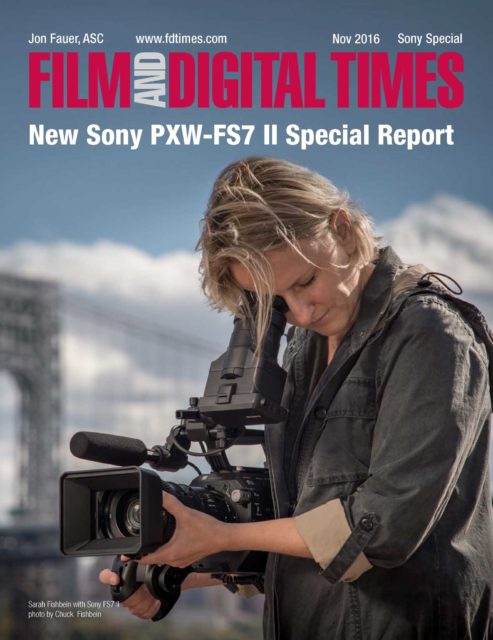Download (free) the FDTimes 12-page Special Report on the new Sony FS7 II — 2 MB PDF.
Sony introduces the new cinéma vérité PXW-FS7 II this November, just in time for NAB NY and InterBEE 2017. The successful FS7 will remain in Sony’s lineup. However, the FS7 II is the model you’ll want for its new Lever Lock E-mount, In-Camera Electronic Variable ND, versatile viewfinder, smarter SmartGrip, and improved interface.
Lever Lock Type E-Mount
The E-mount with new Lever Lock is the most expressive example of this e-minima camera’s elegant design. Imagine the familiar E-mount of previous FS or a7 series cameras. Now, instead of twisting the lens clockwise to secure it within the mount, the new Lever Lock E-mount works like an industry-standard PL, PV or Mitchell style breech lock. The only thing to remember is that the locking ring rotates counter-clockwise to tighten. Incidentally, the Canon C-700 Cinema Lock Mount tightens the same way. While this may seem counter-intuitive at first, direction is clearly marked on the camera. This was necessary because an E-mount lens typically gets progressively tighter as you twist it clockwise.
The new Lever Lock Type E-mount is very strong, securely holding E-mount lenses and third party lens adapters. Reports indicate that the FS7 II Lever Lock Type E-Mount is as rugged as the F55 in ability to hold lenses of similar weights and without supports.
To prepare the mount, first slide the spring-loaded RELEASE safety latch upward and rotate the Lever Lock clockwise until both white dots line up. To secure an E-mount lens: line up its white dot, insert, and rotate the Lever Lock counter-clockwise until the RELEASE latch snaps downward. This prevents accidental removal. You can then tighten the ring further.
To remove the lens, slide the RELEASE latch in the direction of the arrow (up). It remains in the up position, so you don’t have to keep holding it. Then, rotate the Locking Lever clockwise to open the mount and release the lens.
Speaking of lenses, the FS7 II kit comes with the versatile 18-110 F4.0 zoom (E PZ 18–110 mm F4 G OSS). It’s a Super35 format E-mount lens, without ramping (aperture does not change when zooming in) and with fully indexed mechanical focus, iris and zoom barrels. The 18-110 has a manual/servo zoom, manual/autofocus, manual/auto-iris and optical image stabilization. The lens is compact and lightweight (1.1 kg / 2.4 lb). It comes with a removable lens support, which probably can be removed for most situations short of bouncing around in cars, boats or sports.
Electronic Variable ND
The FS7 II includes Sony Variable ND technology, first introduced on the FS5. Variable ND works in 3 ways: as an essential tool, a helpful assistant, and for creative effects.
Essentially: Sony Variable ND can eliminate the task of swapping ND filters in the mattebox because the light-attenuating work is done inside the camera—between the sensor and the rear of the lens.
Helpfully: Have you ever dreamed of adjusting exposure without the depth-of-field altering consequence of fiddling with the iris or the motion-blur changes of shutter control? With stepless, continuously variable ND, you can adjust exposure in an exciting new way.
Creatively: Variable ND works as a creative effect letting you perform depth of field shifts while maintaining constant exposure. For example, you’re tight on a Samurai warrior, wide open on the lens, with a beautifully out-of-focus background. The FS7 II’s Auto ND seamlessly compensates exposure as you quickly stop the lens down to T22, revealing sinister ninjas in the background, creeping into the room.
The FS7 II offers these 3 modes within a 2 to 7 stop range: Preset ND, Manual Variable ND and Auto Variable ND modes.
Preset consists of Clear and 3 user-settable click-stops of neutral density: 1/4-1/128 (ND.6 – ND2.1, which is 2 – 7 stops)
Manual Variable ND provides continuous control (up to 7 stops) with the camera’s variable dial or the index-finger wheel of the SmartGrip. It works like an iris control on the lens, but lets you adjust exposure without changing depth of field. (You have to first turn the Preset knob to any value other than CLEAR and slide the switch to VARIABLE.)
Auto Variable ND takes over exposure control automatically. It also provides a nice way to manage timelapse cinematography in extreme conditions that normally go beyond the iris limits of your lens, for example a single scene that begins on a moon-lit night and continues to bright noon the following day.
Variable ND has a number of other benefits. It lets you use telephoto catadioptric (mirror) lenses like the 500mm Nikkor, whose fixed f/8 aperture cries out for this kind of exposure adjustment. A whole world of esoteric still lenses also await because of all the E-mount to other-mount adapters. Also, you can avoid a trip to the lens repair shop if the iris is frozen wide open or you’re tired of sliding aperture plates in and out of your swirly-bokeh Petzval.
Ergonomic Improvements
The FS7 II designers improved the viewfinder support system and SmartGrip arm mechanism for faster, more comfortable, documentary style camera operating. The viewfinder support bracket is stronger, and the single clamp on the FS7 has been improved with dual clamps for front-to-back and vertical height adjustments. EVF level is maintained with a new square rod system.
Download (free) the FDTimes 12-page Special Report on the new Sony FS7 II — 2 MB PDF.








